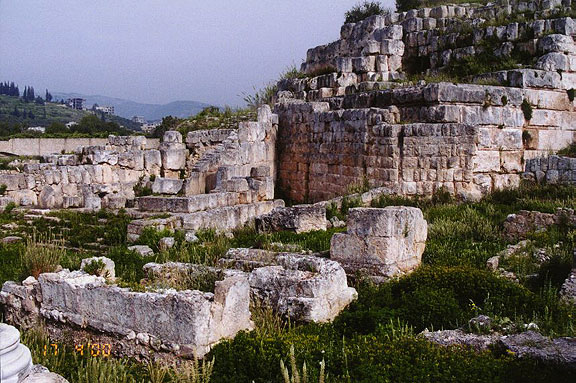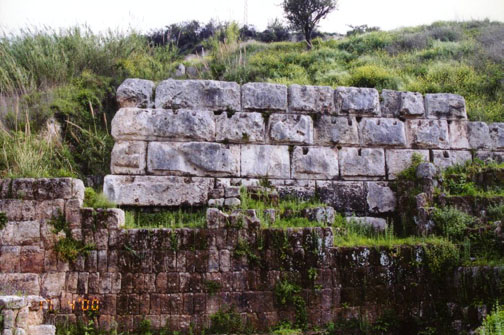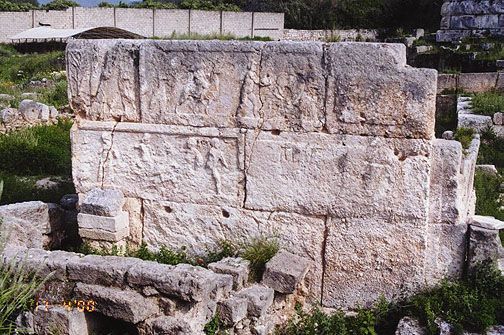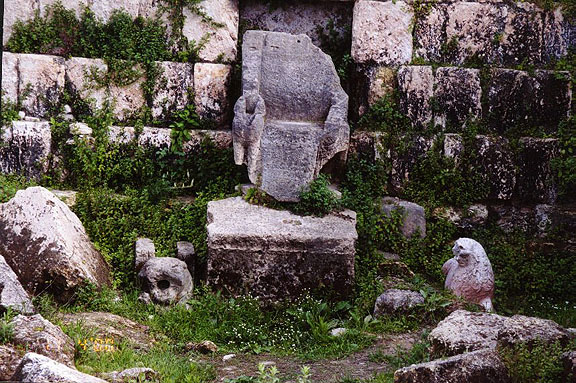

Echmoun
A Phoenician Temple
The principal God of the city of Sidon
and his lover Astarte

Podium for the Phoenician Gods
Phoenicia, ancient designation of a narrow strip of territory on the eastern coast of the Mediterranean Sea, now largely in modern Lebanon. The territory, about 320 km (about 200 mi) long and from 8 to 25 km (5 to 15 mi) wide, was bounded on the east by the Lebanon Mountains. The southern boundary was Mount Carmel; the northern boundary was generally accepted to be the Eleutherus River, now called the KabÓr, which forms the northern boundary of Lebanon.

Early Phoenician stonework (7th century B.C.)
Although its inhabitants had a homogeneous civilization and considered
themselves a single nation, Phoenicia was not a unified state but a group of
city-kingdoms, one of which usually dominated the others. The most important of
these cities were Simyra, Zarephath (Sarafand), Byblos,
Jubeil, Arwad (Rouad), Acco (ĎAkko), Sidon (Sayd‚), Tripolis
(Tripoli), Tyre (Sur), and Berytus (Beirut).
The two most dominant were Tyre and Sidon, which alternated as sites of the
ruling power.

hunting scene in carved figures
The Phoenicians, called Sidonians in the Old Testament and Phoenicians by the
Greek poet Homer, were Semites, related to the Canaanites of ancient Palestine.
Historical research indicates that they founded their first settlements on the
Mediterranean coast about 2500BC. Early in their history, they developed under
the influence of the Sumerian and Akkadian cultures of nearby Babylon. About
1800BC Egypt, which was then beginning to acquire an empire in the Middle East,
invaded and took control of Phoenicia, holding it until about 1400BC. The raids
of the Hittites against Egyptian territory gave the Phoenician cities an
opportunity to revolt, and by 1100BC they were independent of Egypt.

With self-rule, the Phoenicians became the most notable traders and sailors of
the ancient world. The fleets of the coast cities traveled throughout the
Mediterranean and even into the Atlantic Ocean, and other nations competed to
employ Phoenician ships and crews in their navies. In connection with their
maritime trade the city-kingdoms founded many colonies, notably Utica and
Carthage in north Africa, on the islands of Rhodes and Cyprus in the
Mediterranean Sea, and Tarshish in southern Spain. Tyre was the leader of the
Phoenician cities before they were subjugated, once again, by Assyria during the
8th century BC. When Assyria fell during the late 7th century BC, Phoenicia,
except for Tyre, which succeeded in maintaining its independence until about
538BC, was incorporated into the Chaldean Empire of Nebuchadnezzar II and, in
539BC, became part of the Persian Empire. Under Persian rule Sidon became the
leading city of Phoenicia.

Throne of Astarte
When Alexander the Great of Macedonia invaded Asia and defeated Persia in 333BC,
Sidon, Arwad, and Byblos capitulated to Macedonia. Tyre again refused to submit,
and it took Alexander a 7-month siege in 332BC to capture the city. After this
defeat the Phoenicians gradually lost their separate identity as they were
absorbed into the Greco-Macedonian empire. The cities became Hellenized, and, in
64 BC, even the name of Phoenicia disappeared, when the territory was made part
of the Roman province of Syria.
The most important Phoenician contribution to civilization was the alphabet.
Purple dye, called Tyrian purple, and the invention of glass, are also ascribed
to the Phoenicians. Their industries, particularly the manufacture of textiles
and dyes, metalworking, and glassmaking, were notable in the ancient world, and
Phoenician cities were famous for their pantheistic religion. Each city had its
special deity, usually known as its Baal, or lord, and in all cities the temple
was the center of civil and social life. The most important Phoenician deity was
Astarte.
Text from Microsoft Encarta
![]()
![]()